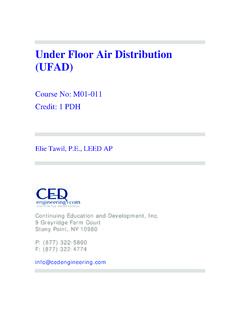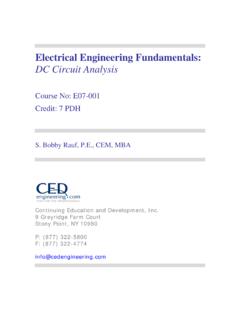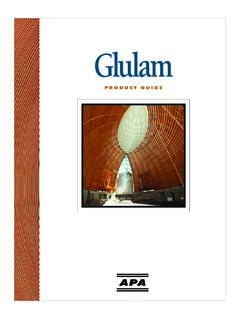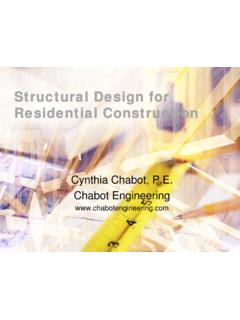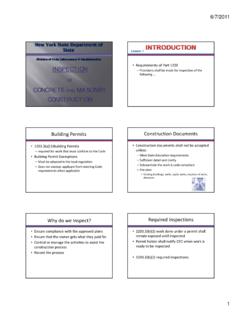Transcription of Determining Allowable Design Values for Wood
1 Determining Allowable Design Values for Wood Course No: S02-004. Credit: 2 PDH. Richard Nolan, Continuing Education and Development, Inc. 9 Greyridge Farm Court Stony Point, NY 10980. P: (877) 322-5800. F: (877) 322-4774. Determining Allowable Design Values for Wood Using Methods from the NATIONAL Design SPECIFCATION. FOR WOOD construction . Published by: AMERICAN FOREST & PAPER ASSOCIATION &. AMERICAN WOOD COUNCIL. 2010. RE Nolan, PE. Thorough Home Inspections & Engineering Service I. Introduction Wood is the most popular building material for residential homes and other smaller buildings. There are many types of wood products on the market used in the construction industry today. Some of the engineered wood products include I-joists, laminated veneer and glued laminated timber. However, the most familiar and well used is still sawn lumber. This course will provide the methodology for Determining the Allowable Design Values to use when designing sawn lumber components, such as beams, headers, trusses, floor joists, decking, etc.
2 However, much of the same methodology and adjustment factors are also applicable to the other types of engineered lumber. This course teaches the methodology used by the National Design Specification (NDS) for Wood construction published by the American Forest & Paper Association and the American Wood Council. It is recommended, but not essential, that the student obtain a copy of this nationally recognized standard. Owning a copy of the NDS will not only increase the understanding of the course material but also be an invaluable source of information for anyone designing wood structures. The NDS contains reference Design Values for all types of sawn lumber and other engineered wood products. The copy of the NDS can be purchased from Page 2 of 41. Lumber Types Sawn Lumber Glued Laminated Timber Graded I-Joists Standard Sizes Laminated Veneer Same visual appearance Etc. Spans 6-32'. Sawn Lumber Laminated Glued I-Joist Veneer Laminated Timber Page 3 of 41.
3 II. Reference Vs. Allowed Design Values There are a few readily available sources which tabulate reference Design Values for all types and grades of sawn lumber. Reference (a) and (b) are two good sources of sawn lumber Design Values . However, it is not appropriate to use the reference Design Values without first adjusting them for the size of the lumber, service condition, type of loading, and the way the lumber is to be supported. Once the reference Design Values have been adjusted for these factors, the wood member may be safely designed to handle the applied loads. The reference Design Values found in various references are referred to in this course as either reference, tabulated or baseline Design Values . Once the reference Design Values have been adjusted for all factors, it is termed the Allowable ' Design value . The Allowable Design value is the value that should be used when sizing/designing wood structural components. This course teaches the methodology for adjusting the reference Design Values for all significant factors in order to arrive at the Allowable Design value .
4 Remember: Reference Values are baseline Values that you start with. These Values need to be adjusted (downward or upward) to account for different conditions which are discussed herein. Reference: a) Nation Design Specification (NDS) for Wood construction , American Forest & Paper Association and American Wood Council, b) Timber construction Manual, American Institute of Timber construction , Page 4 of 41. III. Types of Design Values Below is a list of the Design Values which are typically needed to Design wood components. The actual Design Values that will be used when designing a structural wood component will depend on what the wood component is being designed to do. For example, if a beam is being designed, the Design Values used will typically be bending, shear and compression perpendicular to the grain and modulus (to calculate deflection). Design Values for a column would be compression parallel to the grain and modulus. For a chord in a truss under tension, the tension Design value would be needed.
5 The next slide will illustrate the definitions of the terms perpendicular to the grain and parallel to the grain . Fb Bending (typical beam bending). Ft Tensions (hanging something from timber, truss member under tension). Fv Shear parallel to grain (Beam Design ). Fc Compression perpendicular to grain (Beam bearing). Fc Compression parallel to grain (header support, truss chord in compression, studs in a wall). E modulus of Elasticity (used for displacement calculations or column buckling calculations). Remember: F = Reference (Baseline) Design value F' = Allowable Design value after all Adjustments have been made Page 5 of 41. IV. Wood Grain This slide illustrates what is meant by parallel' and perpendicular' to the grain. Page 6 of 41. V. Factors that Affect Reference Design Values Below is a list of the significant adjustment factors that are applied to the reference Design Values . Not all of the adjustment factors are used on every type of Design value .
6 For example, the bending reference Design value is adjusted for all the factors below except for the column stability factor (CP) and the buckling stiffness factor (CT). The following slides will explain and show you how to determine each adjustment. Temperature, Ct Repetitive Factor, Cr Moisture Content, CM Incising Factor, Ci Load duration, CD Column Stability Factor, CP. Beam Stability Factor, CL Buckling Stiffness Factor, CT. Size Factor, CF Bearing Area Factor, Cb Below is a sample of how to adjust the reference bending value by the factors listed above to arrive at the Allowable bending value that would be used to Design wood in bending. Note that not all of the factors are used to adjust the bending Design value . This formula will be discussed later in further detail. Fb' = FbC D C F C L CM Ct C fu Cr Ci Page 7 of 41. Load Duration Factor (CD). Most reference Design Values may be increased or decreased to account for the duration of load; that is how long the load acts on a structural wood component in aggregate.
7 Reference Design Values may be increased for loads acting less than 10 years and decreased for loads acting more than 10 years. Different combination of loads and load duration factors may be used in order to determine the most limiting case. Frequently Used Load Durations Factors CD1. Load Duration CD Typical Design Loads Permanent (>10 yrs) Dead Load Ten Years (Normal) Occupancy Live Load Two Months Snow Load Seven Days construction Load (Roof Included). Ten Minutes Wind/Earthquake Load Impact2 Impact Load Notes: 1) Load durations factors shall neither apply to the modulus of elasticity E, nor to compression perpendicular to grain Design Values , FC , based on a deformation limit. 2) The impact load duration factor shall neither apply to structural members pressure-treated with water-borne preservatives to the heavy retentions required for marine' exposed conditions, nor to structural members pressure- treated with fire retardant chemicals. Also, the impact load duration factor shall not apply to connections.
8 Page 8 of 41. Moisture (Wet) Service Factor (CM). The strength of wood increases with a reduction in the moisture content. Reference Design Values for sawn lumber assume maximum moisture content of 19%. Wood with a moisture content of 19% or less is considered dry. Kiln dried or seasoned wood would be considered dry as long as it hasn't been exposed to weather long enough to cause re-saturation. If there is a reasonable chance that wood will be subject to conditions favorable to increase its moisture content, then the reference Design Values should be reduced by the factor CM as shown in the table below. Examples of situations where wood is susceptible to increase in moisture content would be freshly cut green' wood, wood used to construct scaffolding that is exposed to weather, wood used as decking, floor joists suspended over ground susceptible to splashing, wood not protected from weather, wood near potentially leaky locations, etc. If the wood is dry then CM = Moisture Content Factors CM a,b,e Strength Property Fb Ft Fc Fc Fv E Frt Fg Sawn Lumber, Visual or Machine Graded -- --d Wet conditions of use MC > 19%.
9 Dimension lumber (including Southern Pine). 5 in. X 5 in. and larger -- --d Decking -- -- -- -- -- Wet conditions if use all Species except Southern Pinec Notes: a) When (Fb)(CF) for dimension lumber of all species 1150 psi, CM = b) When (Fc)(CF) for dimension lumber of all species except Southern Pine 750 psi, CM = ; when Fc for visually graded Southern Pine 750. psi, CM = c) For Southern Pine, use Reference Design Values for wet service conditions Page 9 of 41. Effect of Size (CF). Two types of size factors: Flat use ( , plank) Cfu Adjustment in reference Design value related to the depth of the Sawn lumber, CF. Design Values are affected by size: thickness and width (or depth). For sawn lumber used as a plank (laid flat wise), Cfu applies Many Southern pine Design Values are sorted by width and thickness so CF need not apply Machine graded lumber Design Values already account for CF. The factor is greater than for wood less than 12 nominal in depth and less than for wood greater than 12.
10 In depth The typical use of the size factor for sawn lumber is to adjust the reference Design value for the depth of the piece. Sawn lumber smaller than 12 depth gets an increase in the reference Design Values . Use the table on slide 12 to determine the adjustment factor. Page 10 of 41. Size Factor CF. Some more notes regarding the size factor: Most Southern Pine has Size Factor included in the baseline Design Values with the exceptions of those listed on slide 13. Mechanically Graded Lumber, already included Included for visually Graded Timbers (5 X 5 and larger) up to 12 in depth. Beyond 12 in depth, CF = (12/d)1/9. For decking, except redwood, bending Design Values are based on 4 thickness. When 2 or 3 thick decking is used, the bending Design Values , Fb, for all species except redwood shall be multiplied by the following size factors: CF = for 2 thick and CF = for 3 thick. Page 11 of 41. SIZE FACTORS, CF. SIZE FACTORS, CF- for Sawn Lumber not including Southern Pine Fb Ft Fc Grades Width/Depth Thickness 2 & 3 4.


